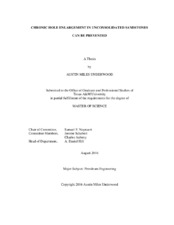| dc.description.abstract | Low-cost engineering design and operational practices are presented that prevent significant enlargement in shallow, unconsolidated sands while drilling. The methodology includes a combination of fluid design, geomechanical design, drilling practices, and a progressive road map that can be followed to achieve gauge hole. The performance incentive is large, including gains in rates of penetration, reduction in cement volumes, elimination of control drilling due to poor cuttings transport, reduced cuttings disposal costs, and reduction in circulating and tripping times.
Operators who do utilize low fluid loss muds use API fluid loss (FL) or HTHP tests to determine the filtration rate. These tests measure the filter cake’s effectiveness against very low permeability filter paper. Fluids with very low values in standard API FL tests may have uncontrolled loss rates in multi-Darcy sands. The common filtration testing methods are also misleading because the initial downhole cake will be composed almost entirely of the sand being drilled and will be highly permeable regardless of the fluid design used.
The changes needed in practice are to use a slightly modified API FL testing apparatus to design fluids that enable cake formation on multi-Darcy formations, to use stability mud weight which is usually relatively low in shallow formations, and to use stabilizers to shear and condition the initial high permeability filter cake.
The research presented provides quantitative insight into these processes. The lab research on the effects of reaming on cake morphology is particularly unique, with implications for elimination of other operational issues, such as stuck pipe. The hidden cost of enlarged shallow sands is greater than generally recognized, while the investment required to drill a near-gauge hole is quite small. The product of this study is an overview of the steps one can follow to develop a fluid design and a field implementation workflow that will reliably reduce wellbore enlargement. | en |


